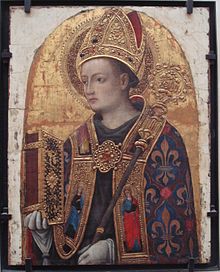
Quick Facts

Biography
Saint Louis of Toulouse (9 February 1274 – 19 August 1297) was a cadet of the royal French house of Anjou who was made a Catholic bishop.
Life
He was born in Brignoles, Provence, (or in Italy, at Nocera, where he spent a part of his early life), the second son of Charles of Anjou "the Lame" and Maria Arpad of Hungary, daughter of the King Stephen V of Hungary. His father was appointed King of Naples by Pope Clement IV, the former secretary to Louis IX of France. The boy was himself a nephew of Saint Louis (Louis IX) and of Mary of Hungary (her great-aunt being Saint Elizabeth of Hungary), and also the aunt of Saint Louis' mother was Saint Margaret of Hungary.
When Charles II of Naples was taken prisoner in Italy, during the war with King Peter III of Aragon that followed the Sicilian Vespers, he obtained his own freedom by giving over his three sons as hostages. The boys were taken to Catalonia, where they were placed under the care of Franciscan friars for their education and held for seven years. Impressed by one of the friars in particular, Arnauld de Villenueve, Louis took up the study of philosophy and theology. Though still held in captivity, Louis was made archbishop of Lyon as soon as he reached his majority. When his older brother died of plague in 1295, Louis also became heir to his father's secular titles; however, when he was freed that same year, Louis went to Rome and gave up all claims to his royal inheritance in favor of his brother Robert of Anjou and announced that instead he would take the Franciscan vows of poverty, chastity, and obedience.
On 5 February 1297, Louis was also consecrated Bishop of Toulouse by Boniface VIII, where his uncle, Alphonse of Toulouse had until recently been Count, but had died in 1271 leaving no heir. In this ambivalently dynastic and ecclesiastical position, in a territory between Provence and Aquitaine that was essential to Angevin interests, despite the princely standing that had won him this important appointment at the age of about 22, Louis rapidly gained a reputation for serving the poor, feeding the hungry, and ignoring his own needs. After just six months, however, apparently exhausted by his labors, he abandoned the position of Bishop. Shortly thereafter he died at Brignoles of a fever, possibly typhoid, at age 23.
Two music theory treatises, De musicae commendacione and Sentencia in musica sonora subiecti, are sometimes attributed to him, but are now thought to be the work of Lodewijk Heyligen (1304-1361).
Veneration



Procedures for his canonization were quickly urged. His case was promoted by Pope Clement V in 1307, and he was canonized by John XXII on 7 April 1317 with the bull Sol oriens. His brother Robert at Naples who owed his crown to Louis commissioned a great altarpiece from Simone Martini, depicting Louis with that other saint in the family, Louis IX of France.
The cult of St Louis of Toulouse became relevant in the Medieval Hungary. His nephew the King Charles I of Hungary (1307–1342) exalted his image and veneration, consecrating churches and a monastery in the settlement of Lippa in his honor, and giving the name of the saint to his eldest son, who later succeeded him on the throne as Louis I of Hungary (1342–1382).
St Louis of Toulouse was not otherwise widely venerated in the rest of Europe, but the Franciscans embraced him, keeping his day in their calendar and removing his relics in 1423 to Valencia, where he was made its patron saint.
He can be recognized in iconography as a boy bishop, often with a discarded crown by his feet.
A polyphonic motet, Flos/Celsa/Quam magnus pontifex, was written in honor of Louis's canonization in 1317. The piece appears anonymously in the Ivrea Codex and has been attributed by modern scholars to Philippe de Vitry.
Legacy
Mission San Luis Obispo de Tolosa, a Franciscan mission in California founded in 1772, is named for him as are the surrounding city and county of San Luis Obispo, California.
Kolleg St Ludwig in Vlodrop, the Netherlands, was dedicated to him (not to be confused with Saint Louis of France, who was king of France and undertook many crusades). The college was founded by Franciscan monks in 1905. It had more than 3000 students until the college was closed and sold in 1984. The building had a large statue of Saint Ludwig of Toulouse on the front of the building. The statue has recently been removed from the building and placed beside the road side on the road from Vlodrop to the college (as a road altar) with a short inscription. The building is preserved as a national monument, even though the present owners (Transcendental Meditation movement) have torn parts of it down. A Vlodrop hotel is also named for Saint Ludwig.
Ancestry
| Ancestors of Louis of Toulouse | ||||||||||||||||||||||||||||||||||||||||||||||||||||||||||||||||||||||||||||||||||||||||||||||||||||||||||||||||||||||||||||||||||||||||||||||||||||||||||||||||||||||||||||||||||||||||||||||||||||||||||||||||||||||||||||||||||||||||||||||||||||||||||||||||||||||||||||||||||||||||||||||||||||||||||||||||||||||||||||||||||||||||||||||||||||||||||||||||||||||||||||||||||||||||||||||||||||||||||||||||||||||||||||||||||||||||||||||||||||||||||||||||||||||||||||||||||||||||||||||||||||||||||||||||||||||||||||
|---|---|---|---|---|---|---|---|---|---|---|---|---|---|---|---|---|---|---|---|---|---|---|---|---|---|---|---|---|---|---|---|---|---|---|---|---|---|---|---|---|---|---|---|---|---|---|---|---|---|---|---|---|---|---|---|---|---|---|---|---|---|---|---|---|---|---|---|---|---|---|---|---|---|---|---|---|---|---|---|---|---|---|---|---|---|---|---|---|---|---|---|---|---|---|---|---|---|---|---|---|---|---|---|---|---|---|---|---|---|---|---|---|---|---|---|---|---|---|---|---|---|---|---|---|---|---|---|---|---|---|---|---|---|---|---|---|---|---|---|---|---|---|---|---|---|---|---|---|---|---|---|---|---|---|---|---|---|---|---|---|---|---|---|---|---|---|---|---|---|---|---|---|---|---|---|---|---|---|---|---|---|---|---|---|---|---|---|---|---|---|---|---|---|---|---|---|---|---|---|---|---|---|---|---|---|---|---|---|---|---|---|---|---|---|---|---|---|---|---|---|---|---|---|---|---|---|---|---|---|---|---|---|---|---|---|---|---|---|---|---|---|---|---|---|---|---|---|---|---|---|---|---|---|---|---|---|---|---|---|---|---|---|---|---|---|---|---|---|---|---|---|---|---|---|---|---|---|---|---|---|---|---|---|---|---|---|---|---|---|---|---|---|---|---|---|---|---|---|---|---|---|---|---|---|---|---|---|---|---|---|---|---|---|---|---|---|---|---|---|---|---|---|---|---|---|---|---|---|---|---|---|---|---|---|---|---|---|---|---|---|---|---|---|---|---|---|---|---|---|---|---|---|---|---|---|---|---|---|---|---|---|---|---|---|---|---|---|---|---|---|---|---|---|---|---|---|---|---|---|---|---|---|---|---|---|---|---|---|---|---|---|---|---|---|---|---|---|---|---|---|---|---|---|---|---|---|---|---|---|---|---|---|---|---|---|---|---|---|---|---|---|---|---|---|---|---|---|---|---|---|---|---|---|---|---|---|---|---|---|---|---|---|---|---|---|---|---|---|---|---|---|---|---|---|---|---|---|---|---|---|---|---|---|---|---|---|---|---|---|---|---|---|---|---|---|---|---|---|---|---|---|---|---|---|---|---|---|---|---|---|---|---|---|---|---|---|---|---|---|---|---|---|---|---|---|---|---|---|
| ||||||||||||||||||||||||||||||||||||||||||||||||||||||||||||||||||||||||||||||||||||||||||||||||||||||||||||||||||||||||||||||||||||||||||||||||||||||||||||||||||||||||||||||||||||||||||||||||||||||||||||||||||||||||||||||||||||||||||||||||||||||||||||||||||||||||||||||||||||||||||||||||||||||||||||||||||||||||||||||||||||||||||||||||||||||||||||||||||||||||||||||||||||||||||||||||||||||||||||||||||||||||||||||||||||||||||||||||||||||||||||||||||||||||||||||||||||||||||||||||||||||||||||||||||||||||||||
